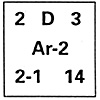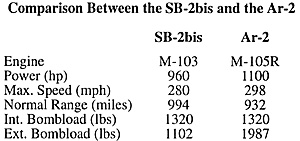 By 1938 the SB-2 was becoming increasingly obsolescent. With any changes that would disrupt the production line forbidden, it had received but minor upgrades since its first flight in 1935. While in production only three years, those years spanned a time during which the aeronautical state of the art advanced incredibly and the SB-2 was no longer the world-beater it used to be. Compared to more recent foreign designs it possessed inadequate performance and bomb-carrying capacity, and was under-gunned.
By 1938 the SB-2 was becoming increasingly obsolescent. With any changes that would disrupt the production line forbidden, it had received but minor upgrades since its first flight in 1935. While in production only three years, those years spanned a time during which the aeronautical state of the art advanced incredibly and the SB-2 was no longer the world-beater it used to be. Compared to more recent foreign designs it possessed inadequate performance and bomb-carrying capacity, and was under-gunned.
A. A. Arkhangelskii, temporary head of the Tupolev design bureau while Tupolev himself was imprisoned in Siberia, began a redesign that would update the SB-2 to contemporary standards. The VVS was much impressed with the performance of the Ju87A in Spain, and asked that a dive-bomber version of this improved SB-2 be designed. Arkhangelskii initially planned on using double-slotted flaps as dive brakes, hence the SB-RK designation (rasresnoye krilo: i.e. slotted wing), but these proved impractical and he was forced to use slatted dive brakes identical to those flown on the Ju88 V7 and V8 prototypes in October 1939 (Soviet espionage at work?).
The SB-RK was a modest redesign of the SB-2 with the most noticeable change being a new extended conical nose with a 7.62mm ShKAS machine-gun in a ball joint to replace the 2 ShKAS guns that lacked all ability to traverse. Other changes included a smaller wing, more powerful engines in a truly elegant streamlined installation, and the ability to carry a greater load of fuel and bombs externally. Despite all the changes, the SB-RK actually weighed some 750 pounds less than the SB-2bis.
In 1941 the Soviets changed their aircraft designation system from an American functional style (1-16, DB-3) to something closer to the German system where all aircraft designed by a design bureau used that bureau's abbreviation (La-5, Su-2). Unlike the Germans, however, the Soviets didn't allocate each bureau a block of numbers. Odd numbers were used only by fighters and even numbers by all other types. As Tupolev was still in Siberia and no SB-RKs had yet rolled off the production line at Zavod No. 22, the aircraft were redesignated Ar-2.
Only 200 were built, beginning in the late spring of 1941, before the factory was evacuated from the Moscow suburb of Fill to Kazan where it began production of the Pe-2. Production of the Ar-2 would undoubtedly have continued had the factory not been forced to move.
Note that the increase in the external bombload was at the expense of fuel, so that the full bombload could only be carried for short distances.
The Ar-2 was an acceptable dive-bomber, albeit somewhat large for the role, but it was a luxury the Soviets could not afford in a war where all resources were needed to maximize production of as few types as possible.
 The Ar-2 in Fire in the East/Scorched Earth
The Ar-2 in Fire in the East/Scorched Earth
In Fire in the East the Soviets were blessed with five SB-RK air units, but these all disappear in Scorched Earth. Instead, the updated air order of battle lists but two Ar-2 units in the entire Soviet inventory, and one of this duo is likely to be swept away by the Luftwaffe's surprise air attack.
Experienced Soviet players treat any Ar-2 they are fortunate enough to possess with great care; after all, it is the only Soviet dive bomber (type D aircraft) they will ever receive. Due to its + 1 die roll modifier, the Ar-2 has a 50% chance of achieving a tactical bombing hit in clear weather. Consequently, Soviet players often hoard this unit while awaiting the opportunity to use it against an aborted Axis air unit or an important rail hex.
On the other hand, knowledgeable German players often take special measures to rid themselves of these pesky fellows. If not dealt with, the Ar-2 can be the most effective bomber in the Soviet repertoire, and so German players usually heave a sigh of relief when the last one eventually exits play.
Back to Europa Number 35 Table of Contents
Back to Europa List of Issues
Back to MagWeb Master Magazine List
© Copyright 1994 by GR/D
This article appears in MagWeb.com (Magazine Web) on the Internet World Wide Web. Other articles from military history and related magazines are available at http://www.magweb.com